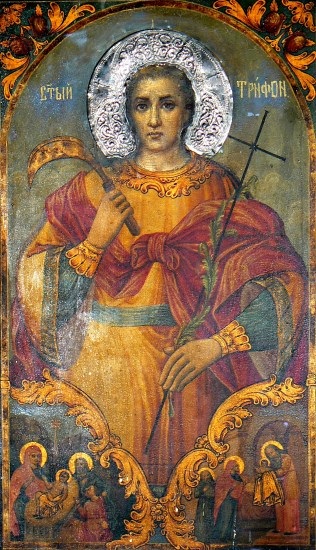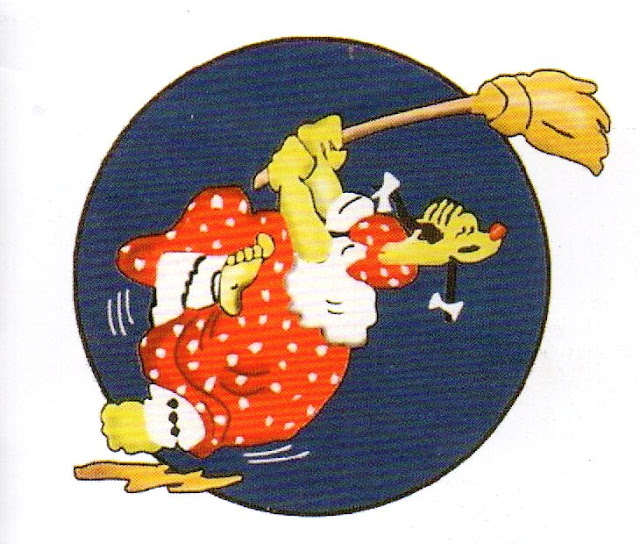The Relics from the East
 |
| Tryphon |
Saint Tryphon and His Devotion
By Fr. Giuseppe Diana
(Translated by L. Pavese)
The relics that came from the Orient.
Saint Basil the Great (329-379 AD), wrote about the relics of the
martyrs: “By touching the relics of the martyrs we participate in the sanctity
and in the grace contained therein.”
The worship of the relics of martyrs spread throughout the Roman Empire,
especially after Emperor Constantine’s Edict of Milan of 313, when freedom of
worship led also to some excesses; to the point that Emperor Theodosius l
(347-395 AD) had to prohibit the transportation of the relics, although his edict did not go actually into effect, and only in a limited way, until the 9th century.
According to the Sinexarion of Constantinople and the Russian calendars,
the reported day of the martyrdom of Saint Tryphon was February 2 but due to
the Candlemas, it was moved to February 3. With the adoption of the Gregorian
calendar, which was enthusiastically welcomed in Europe, Pope Clement VIII’s
December 17, 1595 Decree confirmed February 3 as the day of the celebration of
S. Tryphon in the diocese of Cattaro (now Kotor, Montenegro), and November 10 for the liturgy of the
Universal Church. Today in Kotor,
Saint Tryphon is honored on February 3, but the feast is liturgically
celebrated on November 10.
The people of Kotor also honor Saint Tryphon on January 13, in
remembrance of that day of the year 809, in which the relics of the Saint
arrived in the city.
In that year, a Venetian ship, sailing from Constantinople, sought refuge
from a storm in the Bay of Kotor, and was welcomed by the inhabitants. The
vessel was carrying a big stone sarcophagus that contained the remains of Saint
Tryphon, which were being transported to safety in the West to escape the great
iconoclastic struggle. The sarcophagus was acquired by the people of Kotor.
At that time, the adoration of Saint Tryphon was already widespread throughout the East. The oldest churches dedicated to this martyr had been built in Constantinople by Emperors Justinian and Justin I. They were two basilicas that are mentioned in the “De Aedificiis” by the historian Procopius of Caesarea (500-565 AD).
Saint Tryphon was born around the year 232 in Campsada, Phrygia, which at
that time was part of the Roman province of Apamea (in today’s Turkey). This region fell under the rule of the Roman
Empire in 116 AD and encompassed a large part of Asia Minor.
The name Tryphon is very ancient and can be found in the first book of
the Maccabees of the Old Testament. (Maccabees 1: 11,39-40). The etymological root
“Tryphe” means “person of noble spirit.”
Tryphon lost his father when he was still a child, therefore it was his
mother Eukaria who took care of his Christian upbringing. As a young boy
Tryphon worked on the farm, but in his teens, he became a soldier. The various
images of Tryphon throughout the world represent him as a farmer and a soldier,
that is, what he was as a boy and as a young man.
Tryphon was a teenager when he was martyred during the persecution of
Christians decreed by Emperor Trajan Decius in the year 249 and which lasted
until January 252. (There were seven periods of persecution beginning from the
time of Emperor Nero, and the one in which Tryphon was martyred was the seventh,
and the first one to comprise the entire territory of the Roman Empire.)
During the persecutions, the Christians were forced to offer sacrifices,
often burning some grains of incense in front of a statue of the great emperor.
For Christians, the practice was pagan
and foreign, but refusing to participate meant the loss of all property, jail,
forced labor, torture, and even a death sentence after a trial.
When Tryphon refused, he was brought from his native town to Nicaea, and he was tried in front of Aquilinus, the Roman Prefect of all Asia Minor.
According to the 10th -11th century Martyrium S.
Tryphonis Graecum Code, in which the trial record was supposedly recorded,
Aquilinus asked, “What are you? Tryphon answered, “I am a Christian.”
After being tortured for three days without his agreeing to make a
sacrifice to the gods and to the Roman emperor, Tryphon was beheaded.
Tryphon’s body was taken to Campsada, then to Constantinople and from
there to Kotor. The worship of the relics of
Saint Tryphon spread from Constantinople throughout the Orient.
 |
| Трифон |
The Worship of Saint Tryphon in Southern Italy
While the worship began in the Orient in the 4th century where
it continues today, we can say that the cult of Saint Tryphon in the West began
in the 9th century. In the
year 809, because of the presence of the relics and the great devotion of the
people, the city of Cattaro became the main point from which the veneration of
the Saint spread.
Later, in the 12th century, Cattaro and Bari in Southern
Italy, and other coastal cities of the Adriatic Sea, sealed trade deals. Between the 12th and the 13th
centuries, the ports of Cattaro,
Spalato (Split), Durazzo (Durrës) and Valona became the terminals of the main trans-Balkan routes.
The cult of Saint Tryphon also flourished in Rome, where a church
dedicated to the Saint was consecrated in 961 in Posterula, under Pope John XII
and another one was erected in 1113 in Piazza Fiammetta.
In Apulia, the beginning of the worship of Saint Tryphon can be traced
back to the year 1172, when the Diocese of Cattaro was incorporated in the
Metropolis of Bari, in which it remained until 1828. The order of seating of all the suffraganeous
bishops of the Church of Bari in the celebration of the Provincial Councils is
mentioned on page 45 of Mons. Luigi Stangarone’s book Memorie dell’archivio capitolare (Memories from the Capitular
Archive). At the center there was the archbishop of Bari, to his right sat the
bishops of Giovinazzo, Bitonto, Molfetta, Bitetto, Ruvo, Lavello, and the Abbot
of Santa Maria de Cripta Maiori. To his left sat the bishops of Conversano,
Polignano, Canne, Salpi, Minervino, Cattaro, the Abbot of S. Angelo di Ceglie,
and the Abbot of S. Nicola di Ceglie.
A consequence of the presence of the Bishop of Cattaro in the Metropolis
of Bari was an increase of the knowledge and the devotion of Saint Tryphon, and
it also brought a notable cultural and artistic exchange. A main altar was
erected in the Cathedral of Cattaro with a ciborium modeled after the ones
found in the Church of Saint Nicholas of Bari (built in the first half of the
12th century), the Cathedral of Bari (1230), and the Cathedral of
Bitonto (1240). But the altar of Cattaro surely surpassed all the others in
greatness and majesty. The altar and the
ciborium, true masterpieces of Romanesque art, were consecrated by the Bishop
of Cattaro, Dominio, in the year 1362.
 |
| The reliquary casket of St. Tryphon in Kotor |
During the 15th and 16th centuries, the worship of Saint
Tryphon also flourished in other cities such as Venice, where Dalmatian
immigrants founded a “school” named after Saint George and Saint Tryphon, which
was located in the Church of Saint John of the Temple. In a similar way, the
worship also spread to Mestre, where a statue of Saint Tryphon was placed in
the Church of Saint Lawrence, and, in 1580, an altar in the Cathedral of
Palermo was dedicated to Saint Tryphon.
 |
| Saint Tryphon Cathedral of Kotor (before the 1667 earthquake) |
The town of Alessano (Province of Lecce) also erected an altar in honor of Saint Tryphon in her Cathedral, naming him Patron Saint of the city in 1701. The Saint is also venerated in the regions of San Severo, Marzano di Nola, Tremonti, Nardò (1721), Pulsano (1822), Galatina, and Cerignola.
This is a portion of a translation from Italian that I did a few years ago for a group of Southern Italians, devoted to Saint Tryphon, who live in the United States.
I thought that it might be an interesting read, if only because Saint Tryphon is not a very well known martyr, at least in the English speaking world.
Your comments, as usual, will be very appreciated.
L. Pavese
O Glorious Martyr, and our Protector Saint Tryphon, you who were preceded by the sweetness of Divine Grace, and since your childhood showed such signs of enlightened piety that formed the edification of your fellow citizens, please pray for us so that we will be given the grace to live like true Christians, faithfully observing the obligations we contracted through the Holy Baptism, when we renounced the world and Satan.






Comments
Post a Comment